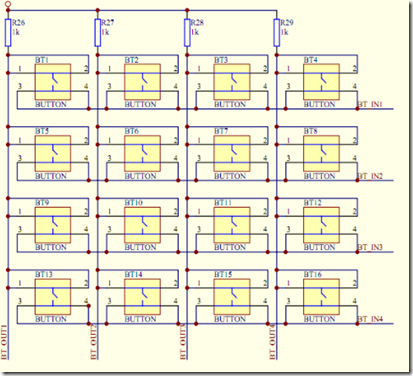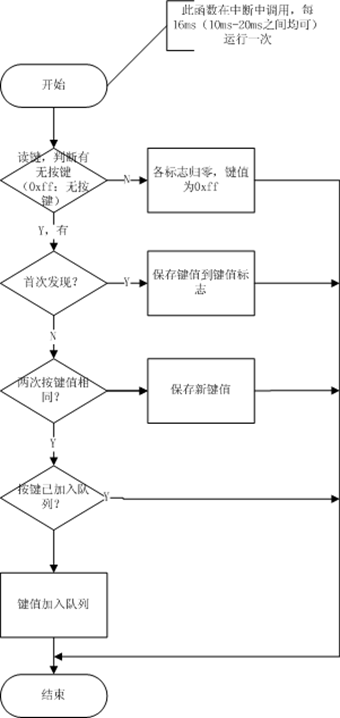|
The OP
Published on 2019-6-9 22:27
Only look at the author
This post is from Microcontroller MCU
| ||||||||||||||||||
|
|
||||||||||||||||||
- 【Posts】msp430 library serial keyboard
- 【Posts】msp430 library serial PWM
- 【Posts】msp430 program library serial series 12864 LCD
- 【Posts】msp430 program library serial series asynchronous serial port USART
- 【Posts】Show off the solar powered Bluetooth keyboard I redeemed on Double Eleven
- 【Posts】[DIY] Logitech K260 keyboard set modified lithium battery power supply and added working instructions
- 【Posts】Do you have any recommendations for low-end mechanical keyboards?
- 【Posts】Defeating two mechanical keyboards at once
- 【Download】Design of keyboard and display module based on MSP430 series microcontroller
- 【Download】MSP430 Programming Library
- 【Download】MSP430 Program Library (V) SPI Synchronous Serial Communication
- 【Download】MSP430 Program Library (IV) printf and scanf function migration
- 【Download】MSP430 series microcontroller data 7 volumes
- 【Download】MSP430G2 Series MCU Principle and Practice Tutorial Complete Edition
- 【Download】2012 TI C2000 and MCU Grand Prix Undergraduate Group_Control System_Xi\'an University of Science and Technology_Intelligent Car Based on MSP430 Series MCU Control.rar
- 【Download】2012 TI C2000 and MCU Grand Prix Intelligent car based on MSP430 series microcontroller control.rar
- 【Design】MSP430 microcontroller matrix keyboard and digital tube experiment (with schematic diagram)
- 【Design】MSP430FR2633 Microcontroller CapTIvate Electronic Lock and Keypad Reference Design
- 【Design】Single-button keyboard based on ESP32-S3 with color screen
- 【Design】CV engineer dedicated keyboard
- 【Design】ESP32 multi-function keyboard instrument + password management
- 【Design】Stm32 keyboard
- 【Circuits】DIY wireless mouse or keyboard
- 【Circuits】How to make a numeric keyboard using XIAO RP2040
- 【Circuits】General frequency converter display-keyboard
- 【Circuits】4-way control keyboard circuit diagram
- 【Circuits】Counting type 10-key keyboard encoding, decoding and display circuit
- 【Circuits】Interrupt scan method matrix keyboard circuit
- 【Articles】51 MCU Series Serial 8 - Independent Keyboard and Matrix Keyboard
- 【Articles】MSP430 DMA Library
- 【Articles】51 MCU Series Serial 1 - MCU Overview
- 【Articles】51 MCU Series Serial 3 - Digital Tube Static Display
- 【Articles】51 MCU Series Serial 4 - Interrupt
- 【Articles】51 MCU Series Serial 5 - Timer
-
msp430 library serial PWM
Timerisacommonbasicdeviceofsingle-chipmicrocomputer,usedtogenerateprecisetimingorotherfunctions;thetimerofmsp430cannotonlycompleteprecisetiming,butalsogeneratePWMwaveformoutputandcapturethemomentvalue(whentherisingedgeorfallingedgearrives)H ...
-
msp430 program library serial series 12864 LCD
Liquidcrystalisoneofthemostcommonlyuseddisplaydevicesinthesingle-chipmicrocomputersystemTheliquidcrystalusedisJinpeng's:OCMJ4X8Cmodel12864liquidcrystalThethreecontrolportsareP31,andP3HardwareIntroduction:430digitalIOport:MSP430F149andMSP430 ...
-
Is there a common anode digital tube with the same package as ARK SR420361K?
Iwouldliketoasktheexperts,isthereacommonanodedigitaltubewiththesamepackageasARKSR420361K?Thankyou
- Bluetooth module parameters - transmit power, receive sensitivity, air rate, what equipment can be used to test these parameters more accurately...
- The headlight step-down chip already has a DIM enable terminal to control the on and off of the headlights, so why add a circuit to control the BAT+ supply...
- TMS320 DSP series and OMAP series
- 430 MCU driver
- Please give me some guidance!
- Free Download | TE White Paper "The Importance of Pressure Sensors in HVAC Refrigeration Systems"
- Things to note when routing high-frequency and high-speed signal lines along the edge of a PCB
EEWorld Datasheet Technical Support
-
"Cross-chip" quantum entanglement helps build more powerful quantum computing capabilities
IBM scientists have achieved "cross-chip" quantum entanglement - successfully entangled two "Eagl
-
Ultrasound patch can continuously and noninvasively monitor blood pressure
A research team at the University of California, San Diego, has developed an innovative wearable
-
Europe's three largest chip giants re-examine their supply chains
At the Electronica 2024 CEO Roundtable held just last week, the CEOs of three chip giants, Infine
- It is reported that Kioxia will be approved for listing as early as tomorrow, and its market value is expected to reach 750 billion yen
- The US government finalizes a $1.5 billion CHIPS Act subsidy to GlobalFoundries to support the latter's expansion of production capacity in the US
- SK Hynix announces mass production of the world's highest 321-layer 1Tb TLC 4D NAND flash memory, plans to ship it in the first half of 2025
- UWB is a new way to use it in cars. Can wireless BMS also use it?
- Filling the domestic gap! China Mobile, Huawei and others jointly released the first GSE DPU chip
- Samsung Electronics NRD-K Semiconductor R&D Complex to import ASML High NA EUV lithography equipment
- Apple reveals the secret of its own chip success: competitors can't use the latest cutting-edge technology
- Problems with STM32 and passive buzzer playing sound
- Embedded Tutorial_DSP Technology_DSP Experiment Box Operation Tutorial: 2-28 Building a Lightweight WEB Server Experiment
- OPA847IDBVR op amp domestic replacement
- AG32VF407 Test UART
- [Digi-Key Follow Me Issue 2] Chapter 1: Sharing on receiving the goods
- What model is this infrared receiver? Which model can be used instead? Thank you
- Selling brand new unopened ZYNQ 7Z020 FPGA core board
- The LORA module used in the lithium battery-powered water meter setting can save energy when 100 water meters are installed in one corridor.
- I would like to ask, when a port is set to RX0, is it necessary to set the input and output direction of this port?
- Why is this year so difficult? It’s even more difficult than during the pandemic. I’m 30 and facing unemployment. I’m so confused.
- Ask about the voltage regulator test question
- [Xiaohua HC32F448 Review] About Xiaohua Semiconductor's UART interrupt sending and PRINTF construction and redirection
- 【BIGTREETECH PI development board】 HDMI output test
- 【BIGTREETECH PI development board】+08. Audio test (zmj)
- [Xiaohua HC32F448 Review] +RTC electronic clock
- 有奖直播报名| 高可靠性IGBT新选择 —— 安世半导体650V IGBT
- 【直播时间】12月19日(周四)下午15:00-16:30
【直播好礼】定制双肩商务包、30元京东卡、吸管玻璃杯
- 安世半导体直播报名中
- 直播主题:安世半导体理想二极管与负载开关,保障物联网应用的稳健高效运行
直播时间:12月17日(周二)下午14:00
报名就有机会获得:定制双肩商务包、30元京东卡、吸管玻璃杯
- PI 电源小课堂 | 无 DC-DC 变换实现多路高精度输出反激电源
- 时间:即日起-12月15日
看视频学习电源干货,答题赢取京东卡!
- 参会有好礼 | 2024 瑞萨电子MCU/MPU工业技术研讨会
- 深圳站:11月30日(周六)深圳湾万怡酒店
上海站:12月06日(周五)上海喜玛拉雅酒店
奖励设置:现金红包、螺丝刀套装或30元京东卡
- Littelfuse 新品赋能电子产品安全可靠并高效, 10+挑战等你探索!
- Littelfuse 应用赋能星球,覆盖了诸多应用痛点及解决办法,邀请工程师一起探索,解锁更多设计力!
- 下载资料赢好礼!看Vicor模块化电源解决方案如何推动创新
- 活动时间:即日起-2024年12月31日
如何参与:点击活动页内您想了解的模块,找到资料下载即可参与抽奖,活动结束后统一发奖!
- 有奖活动|英飞凌高密度双相电源模块为高性能运算平台而生
- 活动时间:即日起-12月15日
活动奖励:蓝牙音箱、氮化镓充电器套装、黑色小背包
- 本周精选下载推荐:电源管理基础Dummies
- 本周小编给大家带来一本超简单、超干货的电子书——《电源管理基础Dummies》!内容深入浅出,排版舒服简洁,分分钟能get到电源管理最核心的知识内容。
EEWorld
subscription
account

EEWorld
service
account

Automotive
development
circle

About Us Customer Service Contact Information Datasheet Sitemap LatestNews
- I want to get started quickly with ARM microcontrollers, what should I do?
- I want to get started with FPGA quickly, what should I do?
- For the introduction to FPGA application development, please give a learning outline
- For the introduction of LPC microcontrollers, please give a learning outline
- Please give a learning outline for the introduction to convolutional neural networks for big data
- Please give a learning outline for children's introduction to microcontroller programming
- Please give a learning outline for the introduction to image processing neural networks
- Chat4.0 domestic version download
- What does iot mean?
- What is LINUX


 Room 1530, Zhongguancun MOOC Times Building,
Block B, 18 Zhongguancun Street, Haidian District,
Beijing 100190, China
Tel:(010)82350740
Postcode:100190
Room 1530, Zhongguancun MOOC Times Building,
Block B, 18 Zhongguancun Street, Haidian District,
Beijing 100190, China
Tel:(010)82350740
Postcode:100190
 京公网安备 11010802033920号
京公网安备 11010802033920号




 提升卡
提升卡 变色卡
变色卡 千斤顶
千斤顶